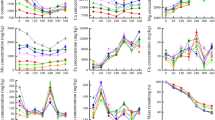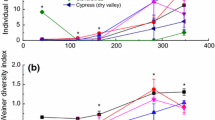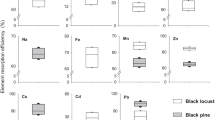Abstract
The effect of incubation setting (greenhouse: GM and field: FM microcosms) on nutrient element dynamics during decomposition of Japanese Konara Oak (Quercus serrata Murray) and Japanese Red Pine (Pinus densiflora Sieb et. Zucc.) litter was studied. Results show a disparity in relative concentrations and amounts of the same type of litter when incubated in different settings. The nutrient mobility, however, showed similar trend. The order of elemental mobility after 12 months forQuercus in FM was: P>K>Mg>C>Mn>Ca>N>Al>Cu>Zn>Fe; for GM it was: P>K>Mn>Mg>C>Ca>N>Al>Cu>Zn>Fe. ForPinus, elemental mobility in FM was: K>Mg>C>Mn>N>P>Cu>Zn>Al>Fe; while for GM was: K>C>Mn>N>Ca>Mg>Cu>Al>P>Zn>Fe. The elements inQuercus that lost their mass were P, K, Mg, Ca, Mn and C while those that increased were N, Cu, Al, Fe and Zn. ForPinus, K and Mg lost their nutrient mass while the other elements had increased or fluctuated but tended to increase. Three patterns of nutrient mobility were observed: first, the concentration increased while the nutrient mass (absolute amount) decreased; second, both concentration and nutrient mass increased; third, the concentration and nutrient mass decreased. On tracing nutrient mobility over time, the linear regression of nutrient element mass and litter element mass was preferred over the carbon to element ratios because the former gave a clearer picture of the relationship. On the over-all, the pattern of nutrient changes in greenhouse microcosms were different from those observed in the field, hence nutrient cycling studies using greenhouse-microcosm approach alone may give inaccurate results.
Similar content being viewed by others
Literature cited
Alexander, M. (1977) Introduction to Soil Microbiology, Second ed. 467 pp, John Wiley & Sons, New York.
Attiwill, P.M. (1968) The loss of elements from decomposing litter. Ecology 49: 142–145.
Berg, B. and Staaf, H. (1980) Decomposition rate and chemical changes of Scots pine needle litter. I. Influence of stand age. Ecol. Bull. 32: 363–372.
Berg, B. and Staaf, H. (1981) Leaching accumulation and release of nitrogen in decomposing forest litter. Ecol. Bull. 33: 163–178.
Beyers, B.J. and Odum, H.T. (1993) Ecological Microcosms. 557 pp, Springer-Verlag, New York.
Blair, J.M. (1988a) Nutrient release from decomposing foliar litter of three species with special reference to calcium, magnesium and potassium dynamics. Plant Soil 110: 49–55.
Blair, J.M. (1988b) Nitrogen, sulfur and phosphorus dynamics in decomposing leaf litter in the southern Appalachians. Soil Biol. Biochem. 20: 693–701.
Byrne, A.R., Ravnick, V., and Kosta, L. (1976) Trace element concentrations in higher fungi. Sci. Total Environ. 6: 65–78.
Coleman, D.C. and Crossley, D.A. Jr. (1996) Fundamentals of Soil Ecology. 195pp, Academic Press, San Diego.
Cromack, K. Jr., Todd, R.L., and Monk, C.D. (1975) Patterns of basiodiomycete nutrient accumulation in conifer and deciduous forest litter. Soil Biol Biochem. 7: 265–268.
Fahey, T.J. (1983) Nutrient dynamics of aboveground detritus in lodgepole pine (Pinus contorta subsp. Latifolia) ecosystems in southeastern Wyoming. Ecol. Monogr. 53: 51–72.
Flanagan, P.W. and van Cleve, K. (1983) Nutrient cycling in relation to decomposition and organic matter quality in Taiga ecosystems. Can. J. For. Res. 13: 795–817.
Gosz, J.R., Likens, G.E., and Bormann, F.H. (1973) Nutrient release from decomposing leaf and branch litter in the Hubbard Brook forest, New Hampshire. Ecol. Monogr. 43: 173–191.
Hinneri, S. (1975) Mineral elements of macrofungi in Oak-rich forests on Lenholm Island, inner archipelago of SW Finland. Ann. Bot. Fenn. 12: 135–140.
Ishii, H., Katagiri, S., Miyake, N., and Sudo, S. (1977) Studies on mineral cycling in a deciduous broad-leaved forest at Sanbe Forest of Shimane University (II) Decomposition rate of Ao horizon and some experiments of leaf decomposition by litter-bag method. Bull. Fac. Agric. Shimane Univ. 11: 55–59.
Jorgensen, J.R., Wellss, C.G., and Metz, L.J. (1980) Nutrient changes in decomposing Loblolly pine forest floor. Soil Sci. Soc. Am. J. 44: 1307–1314.
Katagiri, S., Miyake, N., and Fujihara, Y. (1987) Distribution and Stand structure of natural Japanese Red-pine (Pinus densiflora Sieb et Zucc.) in Sanbe Forest of Shimane University. Bull. Fac. Agric. Shimane Univ. 21: 39–45.
Laskowski, R. and Berg, B. (1993) Dynamics of some mineral nutrients and heavy metals in decomposing forest litter. Scand. J. For. Res. 8: 446–456.
Laskowski, R., Berg, B., Johansson, M., and McClaugherty, C. (1995a) Release pattern for potassium from decomposing forest needle and leaf litter. Long-term decomposition in a Scot pine forest. IX. Can J. Bot. 73: 2019–2027.
Laskowski, R., Niklinska, M., and Maryanski, M. (1995b) The dynamics of chemical elements in forest litter. Ecology 76: 1393–1406.
Lawrey, J.D. (1977) Elemental partitioning inPinus resinosa leaf litter and associated fungi. Mycologia 69: 1121–1128.
Lousier, J.D. and Parkinson, D. (1978) Chemical element dynamics in decomposing leaf litter. Can. J. Bot. 56: 2795–2812.
MacLean, D.A. and Wein, R.W. (1978) Weight loss and nutrient changes in decomposing litter and forest floor material in New Brunswick forest stands. Can. J. Bot. 56: 2730–2749.
Marshner, H. (1995) Mineral nutrition of higher plants, Second ed. 889pp, Academic Press, London.
Microcal (1995) Origin: Users Manual Ver. 4. Microcal™ Software Inc. 471 pp, Northampton, Massachusetts.
O’Connel, A.M. (1989) Nutrient accumulation in and release from the litter layer of karri (Eucalyptus diversicolor) forests of Southwestern Australia. For. Ecol. Manage. 26: 95–111.
Peterson, D.L. and Rolfe, G.L. (1982) Nutrient dynamics and decomposition of litterfall in floodplain and upland forests of central Illinois. Forest Sci. 28: 667–681.
Rustad, L.E. and Croman, C.S. (1988) Element loss and retention during litter decay in a red spruce stand in Maine. Can J. For. Res. 18: 947–953.
Rustad, L.E. (1994) Element dynamics along a decay continuum in a Red Spruce ecosystem, in Maine, USA. Ecology 75: 867–879.
Salamanca, E.F., Kaneko, N., and Katagiri, S. (1997) Comparison of field and laboratory microcosm methods on the mass loss ofQuercus serrata andPinus densiflora leaf litter. J. For. Res. 2: 159–164.
Schlesinger, W.H. (1977) Carbon balance in terrestrial detritus. Ann. Rev. Ecol. Syst. 8: 51–81.
Schlesinger, W.H. and Hasey, M. (1981) Decomposition of chaparral shrub foliage: losses of organic and inorganic constituents from deciduous and evergreen leaves. Ecology 62: 762–774.
Seastedt, T.R. (1984) The role of microarthropods in decomposition and mineralization processes. Ann. Rev. Entomol. 29: 25–46.
Sinsabaugh, R.L., Moorhead, D.L., and Linkins, A.E. (1994) The enzymic basis of plant litter decomposition: emergence of an ecological process. Appl. Soil Ecol. 1: 97–111.
Smith, J.L. and Paul, E.A. (1990) The significance of soil microbial biomass estimation. Soil Biochem. 6: 357–396.
Staaf, H. (1980) Release of plant nutrients from decomposing leaf litter in South Swedish beech forest. Holartic Ecol. 3: 129–136.
Staaf, H. and Berg, B. (1982) Accumulation and release of plant nutrients in decomposing Scots pine litter. II. Can. J. Bot. 60: 1561–1568.
Stark, N. (1972) Nutrient cycling pathways and litter fungi. Bio Sci. 22: 355–360.
Steel, R.G.D., Torrie, J.H., and Dickey, D.A. (1997) Principles and Procedures of Statistics, Third ed. 666 pp, McGraw-Hill, New York.
Stevenson, F.J. (1982) Humus Chemistry. Genesis, Composition, Reactions. 433 pp, Wiley, New York.
Swift, M.J., Heal, O.W., and Anderson, J.M. (1979) Decomposition in Terrestrial Ecosystems. 372 pp, Blackwell Sci. Pubs., Oxford.
SYSTAT (1992) SYSTAT for Windows: Statistics. 750 pp, Evanston, Illinois.
Taylor, B.R. and Parkinson, D. (1988) A new microcosm approach to litter decomposition studies. Can. J. Bot. 66: 1933–1939.
Tukey, H.B., Jr. (1970) The leaching of substance from Plants. Ann. Rev. Plant Physiol. 21: 305–332.
Author information
Authors and Affiliations
Additional information
This study was conducted while the senior author holds a Japanese government scholarship (MONBUSHO Grant No. 920205).
About this article
Cite this article
Salamanca, E.F., Kaneko, N. & Katagiri, S. Nutrient dynamics in decomposing forest leaf litter: A comparison of field and laboratory microcosm approach. J For Res 3, 91–98 (1998). https://doi.org/10.1007/BF02760308
Accepted:
Issue Date:
DOI: https://doi.org/10.1007/BF02760308




